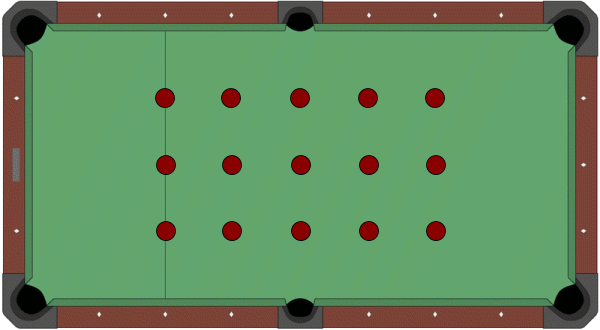Penalty Pool is a billiards game with a twist: players do not accumulate points for making shots, but rather they try to avoid accumulating penalty points for missing shots and for fouls.
Objective
Be the player to accumulate the fewest penalty points during a match comprised of a predetermined number of games (usually three).
Setup
Position fifteen object balls at every intersection of imaginary lines drawn between opposite spots, excluding the three intersections at the head and foot of the table.

Determine who will shoot first; that player takes the cue ball in hand and may place it anywhere on the table to begin play.
Rules Of Play
On every shot attempt, the shooting player must:
- hit any object ball,
- pocket any object ball,
- avoid hitting any rail with the cue ball, and
- avoid hitting any other ball with the cue ball.
Failure to accomplish the above shot requirements results in one or more fouls, with associated penalty points accrued by the offending player:
- Miss all object balls = 3 penalty points and end of turn.
- Fail to pocket any object ball = 1 penalty point and end of turn.
- Hit a rail with the cue ball = 1 penalty point per rail hit (does not end turn).
- Hit any other ball with the cue ball = 3 penalty points per ball hit (does not end turn).
Score penalty points as they occur. It is possible to commit multiple fouls on a single shot, accumulating penalty points for each foul. For example, if a player failed to pocket a ball, hit a rail with the cue ball, and also hit another ball then he or she would accumulate (1 + 1 + 3) 5 penalty points and his or her turn would end. Had the player pocketed a ball, however, he or she would only have accumulated 4 penalty points and would be able to continue shooting.
The player that pockets the final ball on the table reduces his or her penalty points score by 5 penalty points and is awarded 1 game point. All fifteen object balls are repositioned according to the setup diagram above, and that player’s turn ends.
The cue ball is not repositioned unless it would be touching or overlapping an object ball after setup; in that case, the next player takes the cue ball in hand and may place it anywhere on the table to resume play.
At the conclusion of the predetermined number of games, players compare penalty points. The player with the fewest penalty points is the winner; if the penalty points scores are tied, then the player with the most game points is the winner.
Strategy
Penalty Pool encourages a soft touch, spin control, and careful risk/reward management. Early in a game, it is of primary importance to pocket a ball and avoid penalty points. Late in a game, one may risk accumulating penalty points in the hopes of pocketing the remainder of the balls and reducing one’s penalty points by five. Accumulating penalty points, in general, takes the pressure to avoid fouls off of one’s opponent, which can easily give him or her the latitude to pocket all of the remaining balls.